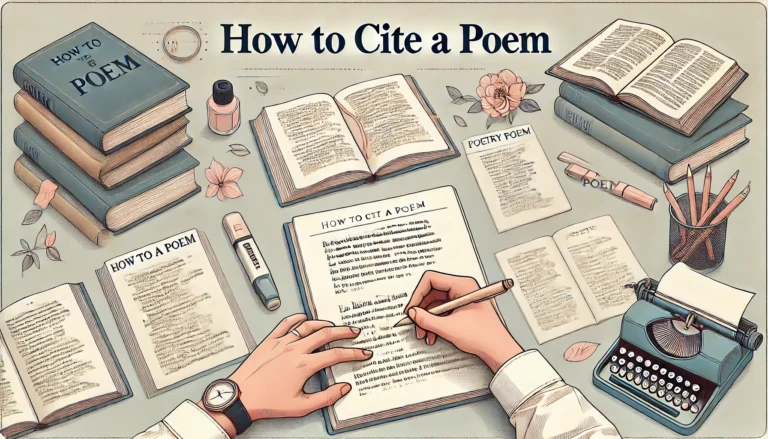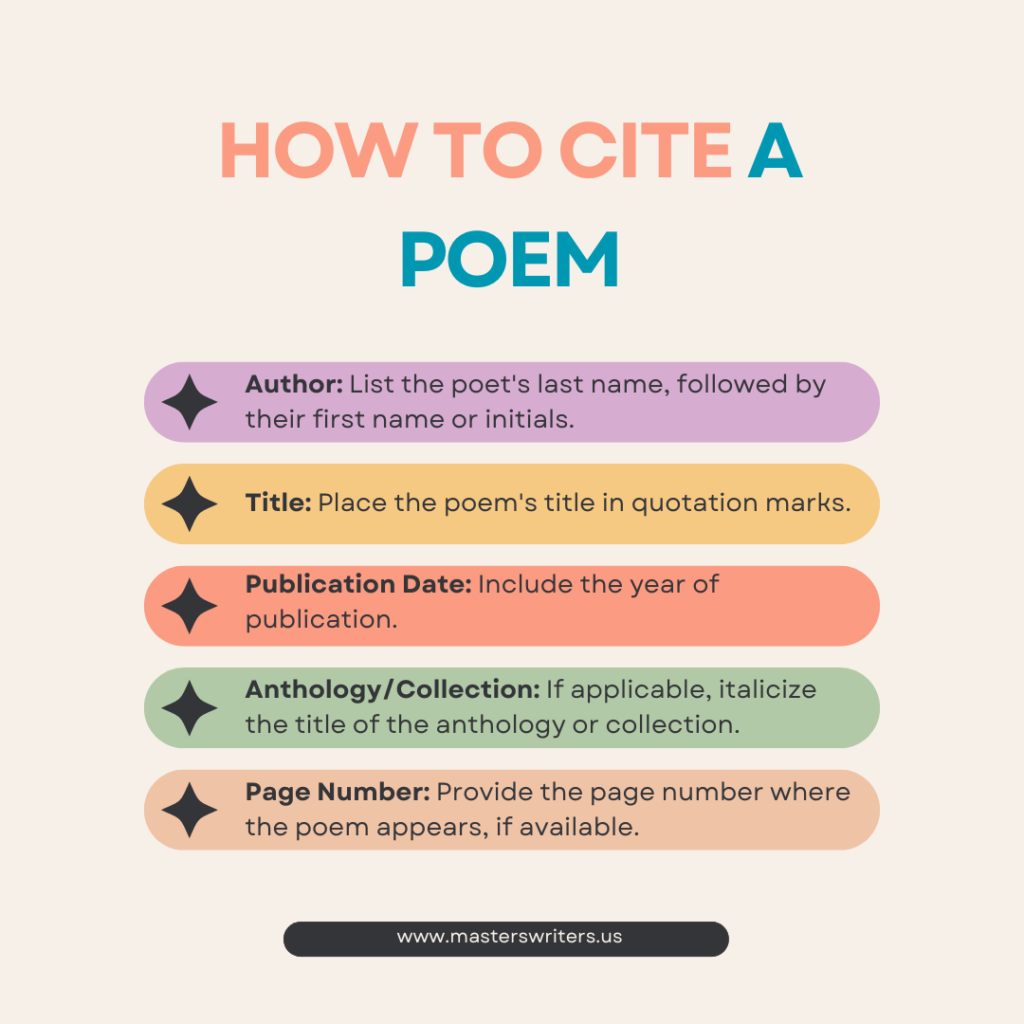Formatting Styles
How to Cite a Poem: MLA and APA Formatting Quotations


Mastering writing skills, including correctly using quotations, is crucial for success, especially in literature and the humanities. Quoting from sources like poems is an essential aspect of writing well-structured essays. When you quote a poem, you use the author’s exact words to enhance your analysis or argument.
When to Use Poem Quotes
Citing poems is especially common for students studying liberal arts, literature, or languages. For instance, it’s challenging to discuss a poet or analyze a literary movement without referring to specific lines of poetry. However, quoting poems isn’t restricted to these areas; you may find them helpful in various essays, such as descriptive, argumentative, or reflective pieces.
Even outside the humanities, using lines from a poem can add depth to your writing as long as it aligns with the theme you’re exploring. While there’s flexibility on when to use poem quotes, following the correct citation guidelines is essential, and the rules can vary depending on your formatting style. Continue reading to learn more about how to cite a poem correctly or use professional help. Need help? You can buy custom essay at Masters Writers.
To get help from an essay writer online, just let us know your requirements, and we will write an original paper with proper formatting.

Citing Poem Quotes in MLA Style
MLA (Modern Language Association) style is one of the most commonly used formats for citing poetry. While it’s relatively simple to learn, mastering the rules takes practice. The citation style for poems in MLA depends on the length of the quote: quotes of up to three lines are considered short, while quotes longer than three lines are considered long.
Element | Format | Example |
In-text citation | (Poet’s Last Name Line(s)) | (Whitman lines 5-7) |
Works Cited | Poet’s Last Name, First Name. “Title of Poem.” Title of Book or Anthology, Editor’s First and Last Name, Edition, Publisher, Year, Page Numbers. | Whitman, Walt. “O Captain! My Captain!” Leaves of Grass, edited by David S. Reynolds, Oxford University Press, 1993, pp. 14-15. |

Citing a Short and a Long Quote
Citing a Short Quote | Citing a Long Quote |
Short quotes can be included directly within the body of your text without starting a new line. | Long quotes must be formatted as block quotes and start on a new line with a half-inch indent from the left margin. |
Enclose the short quote in quotation marks. | No quotation marks are needed for long quotes, but the entire quote should be indented. |
Use a slash (/) to indicate line breaks in the poem, with spaces before and after the slash. | Use a slash (/) to indicate line breaks in the poem, with spaces before and after the slash. |
If punctuation marks belong to the poem, place them inside the quotation marks. If they belong to your text, put them outside. | Double-space the block quote, following the standard MLA formatting for long quotations. |
Each line of the poem should begin with a capital letter, as it appears in the original. | Keep the poem’s structure intact without adding slashes or altering the layout. |
Short Quote Example
In The Waste Land, T.S. Eliot writes, “April is the cruelest month, / breeding lilacs out of the dead land, / mixing memory and desire.”
Long Quote Example
Robert Browning’s Porphyria’s Lover describes the lover’s perspective:
“The rain set early in tonight,
The sullen wind was soon awake,
It tore the elm-tops down for spite,
And did its worst to vex the lake.”
Citing the Title of the Poem
When citing a poem, it’s essential to identify the poet’s last name and the title, especially if you’re referencing more than one poem by the same author. You can do this by mentioning the poem’s title in your text or by including it in a parenthetical citation. If the title and poet’s name have already been mentioned, but you’re unsure if it’s clear, you can repeat them in the citation—this won’t be considered an error.
In addition to the poet’s last name and the poem’s title, your citation should include the line or page numbers if available. Here are some fundamental rules to follow:
- With Line Numbers: If the poem includes line numbers, reference the specific lines in the citation. Use the word “line” in your first citation, then just the numbers afterward.
- Example:
“Hope is the thing with feathers / That perches in the soul” (Dickinson, lines 1-2).
- Example:
- Without Line Numbers (using page numbers): If the poem doesn’t have line numbers, use the page number instead, omitting any commas between the poet’s name and the page number.
- Example:
“The fog comes on little cat feet” (Sandburg 45).
- Example:
- Online or No Numbers: If the poem doesn’t provide line or page numbers (such as online sources), you only need to include the poet’s last name and the title (if required).
- Example:
“Tell me, what is it you plan to do / with your one wild and precious life?” (Oliver).
- Example:
- In-Text Citation Only: If the poet’s name and the poem’s title have been mentioned before the quote and there are no lines or page numbers, you don’t need to include an in-text citation.
- Example:
Here’s what Robert Frost reflects on when he says, “I have promises to keep, / And miles to go before I sleep.”
- Example:
For citing poem titles within your text:
- Short Poem Titles: Place short poem titles in quotation marks.
- Example:
“The Road Not Taken” or “Nothing Gold Can Stay.”
- Example:
- Long Poem Titles: Italicize longer poem titles.
- Example:
The Rime of the Ancient Mariner or Paradise Lost.
- Example:
Finally, remember to include a full citation in the Works Cited page. For poems from a book, follow this format:
- Book Example:
Dickinson, Emily. “Hope is the Thing with Feathers.” The Collected Poems of Emily Dickinson, edited by Thomas H. Johnson, Harvard University Press, 1955, pp. 34-35.
For poems from a website:
- Website Example:
Frost, Robert. “The Road Not Taken.” Poetry Foundation, https://www.poetryfoundation.org/poems/44272/the-road-not-taken. Accessed 10 Sept. 2024.
You may also be interested in how to write a problem statement for a research paper. This information will be helpful in all kinds of student papers, whether you need to cite a poem or write a geography essay. If you need assistance, a geography essay writer can help you write an exceptional paper.
How to Cite a Poem in MLA?
When citing a poem in MLA format, the method depends on whether you’re citing the poem in-text or on your Works Cited page. Here’s a breakdown:
In-Text Citation
For short quotes (up to three lines), place the poem’s title in quotation marks and use a slash (/) to indicate line breaks. Include the poet’s last name and line numbers in parentheses.
- Example:
“I have promises to keep, / And miles to go before I sleep” (Frost lines 13-14).
For long quotes (four or more lines), use a block format, start the quote on a new line, indent it half an inch, and keep the poem’s original formatting. No quotation marks are needed.
- Example:
Robert Frost describes a moment of reflection:
The woods are lovely, dark and deep,
But I have promises to keep,
And miles to go before I sleep,
And miles to go before I sleep. (lines 15-18)
Works Cited Page
Include the poet’s name, the poem title in quotation marks, the book title in italics, the editor (if applicable), publisher, year, and page numbers.
- Example:
Frost, Robert. “Stopping by Woods on a Snowy Evening.” The Poetry of Robert Frost, edited by Edward Connery Lathem, Henry Holt and Company, 1969, pp. 224-225.
How to Cite a Poem in APA Style?
APA style, commonly used in social sciences, has specific rules for citing poetry. Here’s a breakdown of how to cite short and long poem quotes in APA style:
- Short Quotes (under 40 words):
- Include quotation marks.
- Line breaks within the poem are indicated by a slash (/).
- Incorporate the quote within your text without starting a new line.
Example (In-text citation for a short quote):
In Frost’s poem, “The Road Not Taken,” the speaker reflects, “Two roads diverged in a yellow wood, / And sorry I could not travel both” (Frost, 1916, lines 1-2).
- Long Quotes (over 40 words):
- Use block formatting (no quotation marks, new line, indented 1.3 cm from the left).
- Maintain the original formatting, including line breaks.
- Double-space the block quote.
Example (In-text citation for a long quote):
In Song of Myself, Whitman writes:
“I celebrate myself and sing myself,
And what I assume you shall assume,
For every atom belonging to me as good belongs to you” (Whitman, 1855, lines 1-3).
Complete Reference for a Poem in a Book:
Format:
Poet’s Last Name, First Initial. (Year). Poem title. In Editor Initial. Last Name (Ed.), Book title (pp. xx-xx). Publisher.
Example:
Dickinson, E. (2019). A book. In A. Eyre (Ed.), Emily Dickinson: Selected Poems (pp. 55-56). Mount Orleans Press.
Complete Reference for a Poem from a Website:
Format:
Poet’s Last Name, First Initial. (Year, Month Day). Poem title. Retrieved from http://WebAddress.
Example:
Whitman, W. (1855). Song of Myself. Retrieved from https://www.poetryfoundation.org/poems/45477/song-of-myself
How to Cite a Poem in Harvard Style?
Citing a poem in Harvard style is similar to citing other sources but requires attention to detail. Here’s a breakdown of how to correctly cite a poem in this format:
In-text citation:
When citing in-text, include the poet’s last name, the year of publication, and the page number (if available). You can reference the stanza or line numbers instead if you’re quoting directly from an online poem.
Example (with page numbers):
According to Hughes (1951), “I, too, sing America. / I am the darker brother” (p. 23).
Or:
As Hughes (1951) wrote, “I, too, sing America. / I am the darker brother” (p. 23).
Example (with line numbers):
(Larkin, 1964, lines 10-12).
If you’re paraphrasing or referring to the poem generally, only include the poet’s name and the year of publication.
Example (paraphrasing):
According to Angelou (1978), poetry often reflects profound personal experiences.
Or:
Angelou’s (1978) work frequently explores themes of resilience and self-expression.
Reference list entry:
In your reference list, provide the full citation for the poem, including the poet’s name, title (in italics), the year of publication, and details about the book or collection (if applicable), including the editor’s name and publisher.
Example (from a book):
Hughes, L. (1951). I, Too, Sing America. In The Collected Poems of Langston Hughes. Random House.
Example (from an online source):
Larkin, P. (1964). The Whitsun Weddings. Poetry Archive. Available at: https://www.poetryarchive.org/poem/whitsun-weddings (Accessed: 11 Sept. 2024).
Ensure the poem title is italicized, along with the title of any book or anthology it appears in. Include the URL and access date if you’re citing an online poem. Always follow your institution’s guidelines, as there may be slight variations in citation formatting.
Tips and Tricks on How to Cite a Poem
Whether you’re new to poem citations or have some experience, these tips will help you format and use poem quotations effectively, regardless of your citation style.
- Read the Poem Fully: Before quoting, ensure you’ve read the entire poem to grasp its meaning and the author’s intent. This will help you select the most relevant lines to your essay or argument.
- Explain Your Choice: When you use lines from a poem, provide context in your work. Explain why you chose those specific lines, their significance, and how they connect to your essay’s theme.
- Avoid Overquoting: Quoting too much can take away from your original analysis. Consider paraphrasing when appropriate to balance your voice and the poem’s words. Remember, your work should showcase your insights.
- Use Ellipses When Needed: If only parts of the poem are relevant, don’t feel obligated to quote entire sections. You can skip unnecessary lines using ellipses (…) to indicate omitted text. Alternatively, create multiple quotes and incorporate them within your analysis.
- Embed Your Quotes: Make poem quotes a natural part of your sentences. You can introduce them at your sentence’s beginning, middle, or end. For example, Much like Sylvia Plath, “the bell jar hung, suspended” over her world of isolation.
- Know Your Citation Style: Each format (MLA, APA, Harvard, etc.) has unique rules for citing poems. Double-check the guidelines specific to your style to ensure your poem citations are correctly formatted.
- Proofread for Accuracy: During your final review, double-check your citations for both content accuracy and formatting consistency. This ensures you avoid errors and present your quotes in the best possible way.
For now, before you refine your professional skills, we are here to help you! Do not hesitate to contact our service, no matter what kind of help you need, whether it’s a poem citation or physics homework help.
To Sum Up
Properly citing poems is essential for maintaining academic integrity and ensuring readers can trace the source. Understanding the rules for short and long poem quotations is crucial, whether using MLA, APA, Harvard, or another citation style. Short quotes are embedded in the text with quotation marks, while long quotes are formatted as block quotes. Additionally, the poem’s title, publication details, and in-text citations should be carefully structured to follow the guidelines of the specific citation style. With these tips, you can confidently integrate poem quotes into your work while adhering to the appropriate formatting standards.

How to Cite a Poem Quickly?
Use our professional service to solve your citation issues for good.
FAQs
How do I reference a poem?
To reference a poem, include the poet’s name, the title of the poem (in quotes or italics depending on the style), the title of the book or collection, the editor (if applicable), publication details, and page numbers (if available). The format varies depending on the citation style (MLA, APA, Harvard, etc.), so be sure to follow the specific guidelines for your chosen format.
Is a poem italicized or in quotes MLA?
In MLA style, short poem titles are enclosed in quotation marks, while long poem titles (such as epics) are italicized. For example, “The Road Not Taken” would be in quotes, while The Odyssey would be italicized.
How to properly cite a poem?
To properly cite a poem, include the poet’s name, the title of the poem, and the source where the poem is found. Depending on the citation style, you will also need details such as the editor’s name (if applicable), publication year, page numbers, and publisher. For online sources, add the URL and access date.
Example (MLA style):
Frost, Robert. “The Road Not Taken.” Mountain Interval, edited by Henry Holt, 1916, pp. 1-2.
Example (APA style):
Frost, R. (1916). The road not taken. In Mountain Interval (pp. 1-2). Henry Holt and Company.
Example (Harvard style):
Frost, R. (1916). The Road Not Taken. In Mountain Interval. Henry Holt and Company.
For online sources, remember to include the URL and access date:
Example (Online MLA style):
Frost, Robert. “The Road Not Taken.” Poetry Foundation, https://www.poetryfoundation.org/poems/44272/the-road-not-taken. Accessed 12 Sept. 2024.
How do you cite a quote in MLA format?
In MLA format, short quotes are enclosed in quotation marks and incorporated within the text. Use a slash (/) to indicate line breaks in the poem. If the quote is longer than three lines, format it as a block quote without quotation marks. In-text citations include the poet’s last name and the line numbers.
Example (Short quote):
In Frost’s poem, the speaker reflects, “Two roads diverged in a yellow wood, / And sorry I could not travel both” (Frost, lines 1-2).
Example (Long quote):
In The Love Song of J. Alfred Prufrock, Eliot contemplates:
“Let us go then, you and I,
When the evening is spread out against the sky
Like a patient etherized upon a table.”
(Eliot, lines 1-3).
In the long quote, notice the block format without quotation marks and the line breaks presented as they appear in the poem.

